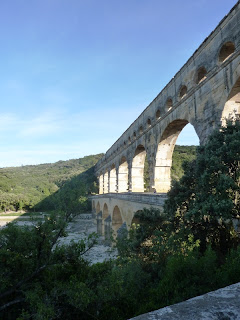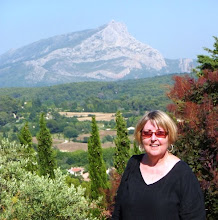One of my must sees was the lavender fields in the Provence area. Unfortunately, I got some kind of bug or allergy thing that kept us at home for almost 2 days, and that severely cut into my lavender looking. We just never got far enough north to see the fields.
So I took this picture of our guide book just in case we saw none and hoped to see some fields from the train as we headed back to Paris.
Here is Trout waiting in the TGV station. The TGV is France's high speed train service. We were able to go from the Aix TGV station to Paris CDG airport in about 3 hours. From my research, I learned a way to get tickets online at just the right time to get the cheapest fares. It cost us only 25 Euros each for this trip. Very cheap indeed.
I sat next to the window looking for lavender. I saw lots of fields. Most of them had sunflowers and farm buildings. That wasn't a bad thing.
Some had nuclear power plants. We don't think that's a bad thing either. In Europe, these plants are public utilities and are built to consistent standards of quality and design. The profit motive isn't present so they don't have the lowest bidder cost overruns and constantly changing design and quality issues present in the US.
We saw some mountains in the distance past the farming areas.
And finally a few lavender fields along with the hay and corn. Of course, where there's a wall even way out here, there's graffiti.
One of the other things I really wanted to visit in Provence is the Pont du Gard. It was built in the 1st century to carry water from what is now Uzes to what is now Nimes. It is the highest of all extant Roman aqueducts and the 2nd best preserved. The Wikipedia article linked provides detailed information about it.
The site is open after dark and as you can tell from the pictures, we were there late in the day. There were very few visitors. Not much was open except the bathrooms, thank goodness.
This thing is big. That's me in the yellow top.
The aqueduct is mostly underground, but here it goes over the Gardon River. On a busier day there would be lots of swimmers and sunbathers along the flat shore.
The structure is not only high but also massive.
Something about this part of France was very comfortable to me. Perhaps it has to do with the limestone or dolomite in the bed of the river. It's much like what you see in the Hill Country of Texas.
Although I didn't get a great picture of it, the base of the aqueduct is so strong that it has withstood numerous floods over the past 2000 years.
Don't tell the kids with the spray cans, but one of my favorite parts was the very old graffiti etched into the limestone. French journeyman masons were required to visit the Pont du Gard as part of their traditional tour around France. This is evidence of one of them from 1783.
There may be older etched graffiti, but this was the oldest I found. It has the typical printed capital letters from the time and is from 1181, I think. With the dotted cross in the upper left, maybe a Crusader passed by here.
Most of the travel info I found encouraged people to take a picnic, walk across the river and eat it looking up at the aqueduct. We were awestruck enough that we didn't even think about food.























